I live near a local fishing pond that attracts a few fish-eating birds, particularly in the late winter and early spring. For the last few days there’s been a pair of Common Mergansers on the pond and yesterday morning I was finally able to get relatively close to them for a few minutes. The pond was still about half covered with ice but it’s melting fast.
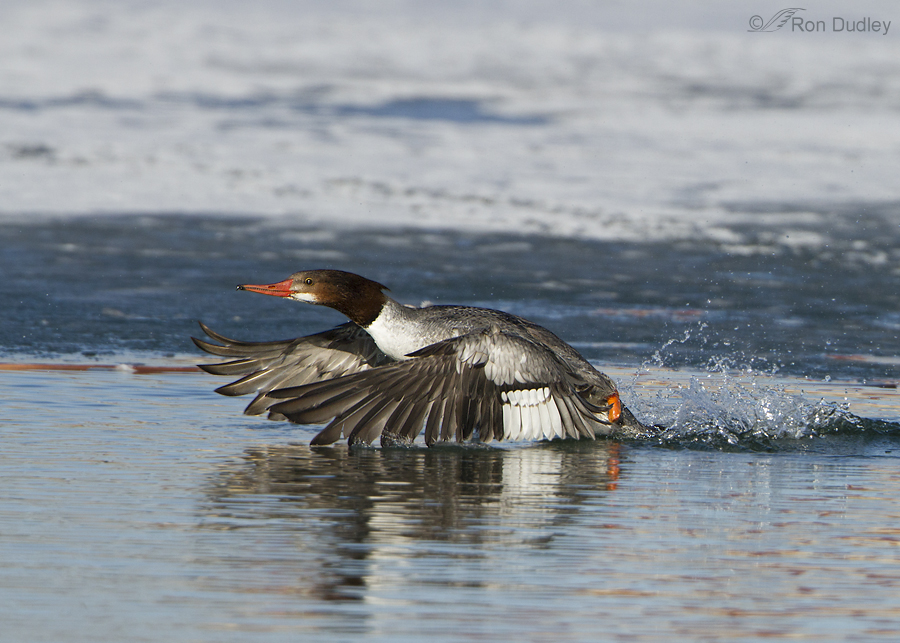
1/2500, f/7.1, ISO 500, 500 f/4, 1.4 tc, natural light
Most of the time there wasn’t much action with the cormorants but once, when this bird apparently thought its companion might have caught a fish, it rushed over to investigate. It wasn’t until this morning when I began culling and processing the images that I noticed that it was missing its left foot.
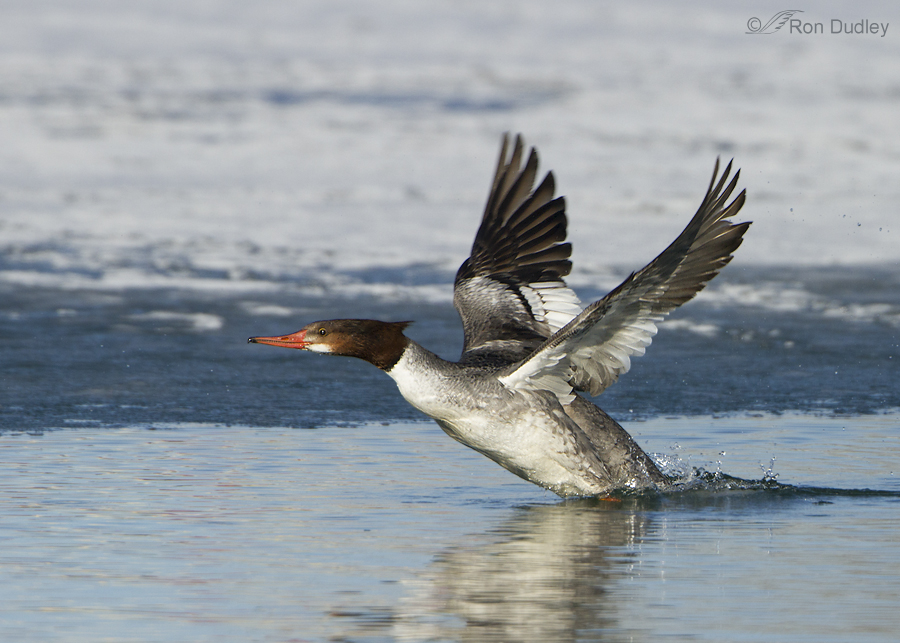
1/2500, f/7.1, ISO 500, 500 f/4, 1.4 tc, natural light
Since they use their webbed feet to help propel them along the surface of the water this bird could really scoot for having only one foot.
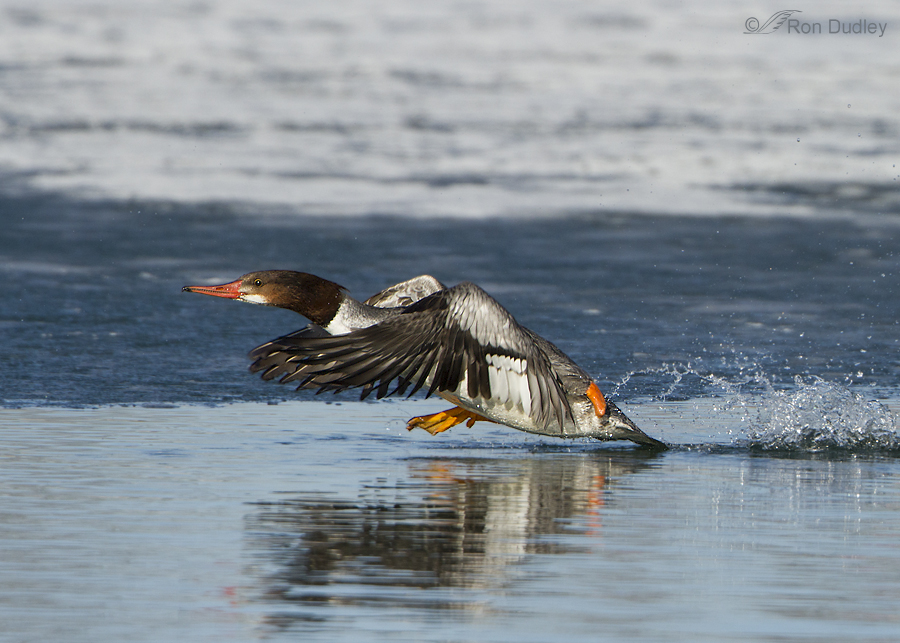
1/2500, f/7.1, ISO 500, 500 f/4, 1.4 tc, natural light
This image shows the missing foot best.
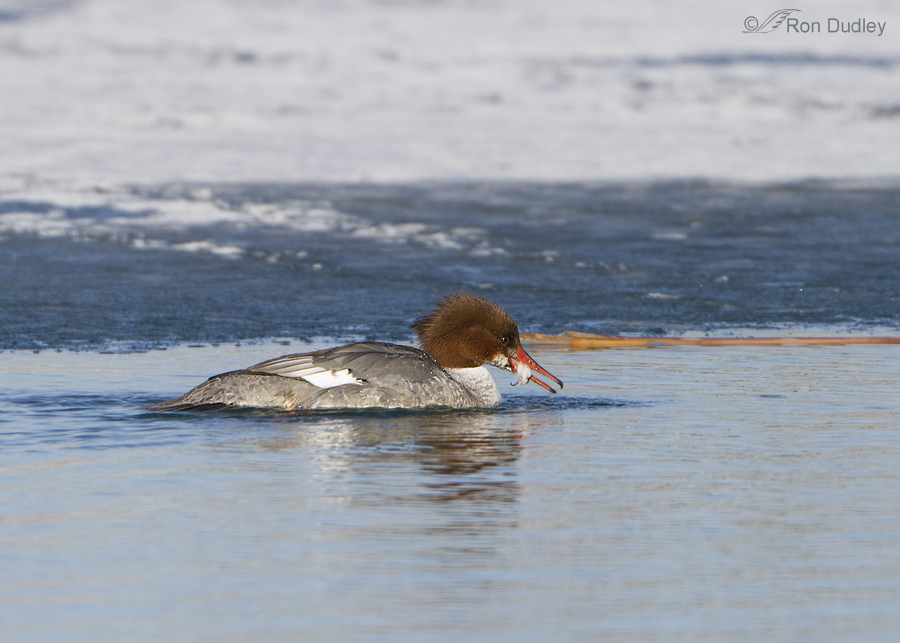
1/2000, f/7.1, ISO 500, 500 f/4, 1.4 tc, natural light
This shot, and the next two, are of the other merganser. As you can see it had some kind of fishing lure/hook stuck in its lower mandible. It doesn’t look like a typical lure so perhaps it’s what’s left of a fish that it had tried to swallow when the hook and/or line got stuck in its bill.

1/2000, f/7.1, ISO 500, 500 f/4, 1.4 tc, natural light
I was at the pond for perhaps an hour and the merganser had the “object” in its bill the entire time. It would occasionally attempt to dislodge whatever it was, as it’s doing here, but without success.
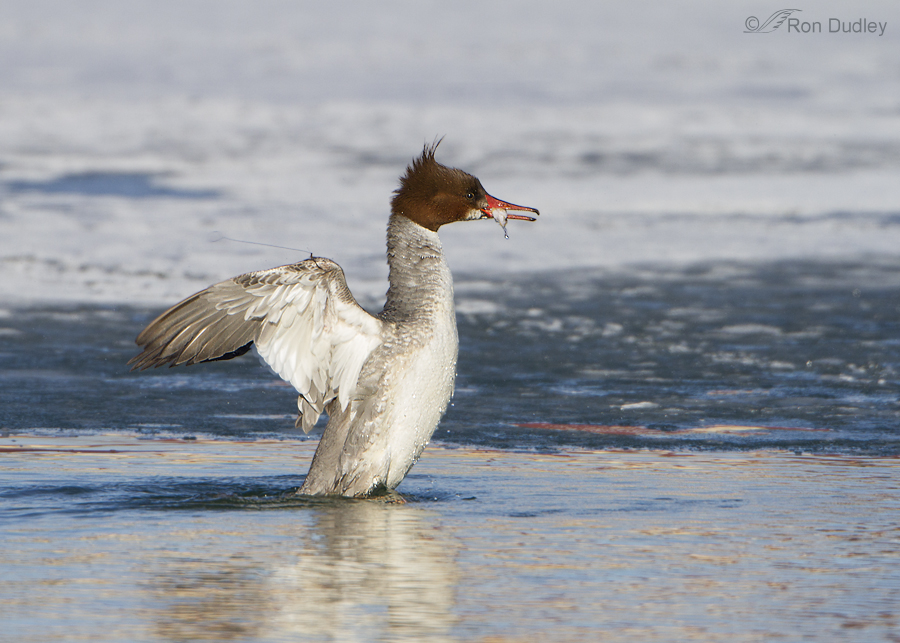
1/2000, f/7.1, ISO 500, 500 f/4, 1.4 tc, natural light
Something else I didn’t notice until this morning was what looks like fishing leader/line coming off the “elbow” of the right wing. The one-footed merganser seems to have adapted to its handicap (which I suspect may also have originally been caused by fishing line) but this bird is likely doomed to starvation.
The fishing line mess at this pond is atrocious. There was discarded line littering the shore and the fishing dock was covered with it, frozen into the morning frost on the floor and elsewhere – despite the fact that there were several receptacles on the dock for disposing of fishing line. I saw another domestic duck that morning with line wrapped around its body. I live about a half mile from the pond but twice in the past there have been Mallards wandering around my front yard with fishing line entangled in their wings and feet. One of them couldn’t fly and I spent hours trying to rescue it and remove the line (thankfully, I was eventually successful).
I know it’s an old story but in my opinion fishermen as a group need to clean up their act. I understand that snagged line often cannot be retrieved but as much of it as there is along the shore and on the dock I can only imagine how much there is at the bottom of the pond waiting to ensnare and entangle multiple species of hapless diving birds.
I wonder if Murray City Parks ever makes an effort to snag the bottom of the pond for fishing line. The pond is shallow and small and it seems to this observer that such an operation would be relatively cheap and easy.
And very much worth the effort!
Ron
Note: A few minutes after making this post I noticed that even the first merganser may have have fishing line entangled on its right foot. Look carefully at the third image down from the top.


I just saw picture #3 on a DWR Facebook post. Based on your last post in this thread, I assume you are aware, but thought I’d let you know.
Thanks for the heads-upp, Budd. I hadn’t seen it on the DWR FB post. Apparently they (DWR) took the image from the online Tribune article as that version of the image doesn’t have my copyright on it.
People can be so thoughtless! How can they leave destructive material just lying around?? Thanks for sharing this. Know any sites for fishermen? It needs to be shared with them. It also seems like this would be a great project for a group od scouts to clean this up.
Charlotte
Update – another bird photographer, Richard Young, also photographed the merganser with the fish hook in it’s mouth and posted the photo on UBIRD. Birder Jeff Cooper saw the post and notified Tonya Kieffer of Utah DWR about the situation with the mergansers and she or her staff will investigate to see if anything can be done.
This is an atrocious conflict with humans. I think it’s shameful that humans simply “don’t know any better” than going fishing. If they want fish so much, let them go and buy it at a store. It makes me sick to watch this (sorry), but good shots anyway.
Maria, I agree that it’s difficult not to feel that way when presented with scenes like this. But I don’t think that fishing as a human activity is going away soon, so IMO our best bet is education, enforcement and nurturing an empathy for the avian (and non-avian) victims.
You’re right, education is the best weapon, but this reality is hard to bear with. I used to go fishing when I was a kid; now I see the ongoing conflict with humans, as usual, we have the upper hand.
So sad. I wonder if you could submit your fishing-line story and photos to the editor of a local newspaper. Surely, there will be somebody in the community that would help clean up the mess, as least on the docks and shore. In S. California, there is a “Heal the Bay” organization. Among other things, it organizes groups to clean up the beaches, like Santa Monica, Redondo Beach, and Long Beach. Sometimes the groups consist of clubs or places of employment, or just volunteers from the community that read about it in their local newspapers. The “Heal the Bay” group does this in addition to the clean-up by Parks and Recreation. Everyday, litter on the beach, like cigarette butts, styrafoam, plastic washes up and causes harm to shorebirds. Maybe some scout troops or other organizations could make it a project to help clean up the fishing lines. Is there a group back there interested in the environment that would be willing to organize a clean-up group and distribute educational material? Maybe a newspaper article would bring wider attention to this disgrace.
I already have plans similar to those you suggest, Susan. I’m aware of a local newspaper columnist who regularly does very effective articles on outdoor and conservation subjects and I plan on contacting him about this. I also plan on contacting Murray City Parks and possibly Mayor Snarr to see if the parks department can do anything about enforcement and perhaps even dragging the bottom of the pond (relatively small and shallow) intermittently for fishing line. Everyone will be “out of the office” for the holiday but I’ll email them with a link to this blog and a plea for help either tonight or in the morning.
Good for you, Ron. I will be interested in the outcome.
I just heard back from the rehabber I contacted about the possibility of rescuing these birds. As I suspected, she said that it would be close to impossible to catch the mergansers since they’re capable of flying. She also said that if they get to the point that they’re debilitated enough to be caught, they would make the effort. I’ll let them know if that happens and I see it.
It would be nice if the Utah legislature would take up this issue along with lead shot. The news story of the Zion NP condor that died of lead poisoning along with your great photos posted here make a compelling argument for stronger laws.
I agree with you wholeheartedly, Dennis. But it is, after all, the Utah State Legislature…
Oh, Ron— this was heartbreaking. Thanks for spreading the word with your wonderful photography. I wonder if there’s a scouting troup in your community that would take on a cleanup?
That’s a good idea, Harmony – I’ll ask around. That would at least help with the fishing line around the shore.
The above is so common here in central Florida. It’s sad to see it’s happening up there as well. I thought maybe it was just our fishing piers that were a problem. With all of the education boards and line bins, they just don’t seem to care.
Your pictures are beautiful though, even though they have a sad story.
Some care, Dina – there’s just way too many who don’t…
This is a painful story to read. It breaks my heart to see any wild animal (or domestic, for that matter) harmed by careless humans. Beautiful photos, though, as always.
Thank you, Susan.
Having grown up on the coast of Va. ,N.C.,I always noticed how bad the trash and fishing tackle debris seems to follow the activity of fisherman. I know people have changed some since I was younger but things still seem the same in this regard. It may be they are on a one track mind set . That is to catch fish in a hurry,drink a few beers and go home. Not all fisherman are like this ,think fly fisherman up on intimate streams ,truly a different crowd than the moter boat crowd. Not trying to point fingers here just making an honest observation from my point of view.
Eldridge, I think part of the change over the years has been increased population = more fishermen using limited resources.
Ron, as an avid fisherman and birder in Florida, I understand your concern. As you can imagine, Florida is a major fishing destination for visitors from around the world. With a huge number of fishermen, the discarded line and hooked bird problem is immense. To its credit, the Florida Fish and Wildlife Commission (FWC) has committed to an extensive education program and dispenses information widely on what to do about birds/animals which are accidentally hooked or fouled in line. Also, popular shore fishing locations and boat ramps/marinas/docks have been supplied with line discarding stations. Of course, all of this only works if fishermen police each other.
Another tool is for us all to carry a list of phone numbers to call if we find an injured bird or animal we can’t take care of ourselves. In Florida, the FWC usually has a number for a local rescue service they can put us in touch with.
Hope your Mergansers make it, but it’s sad anytime wildlife succumbs to human ignorance.
I know exactly how you feel, Wally. As a bird photographer I have similar emotions regarding unethical nature photographers and how they reflect on the rest of us.
I’ve notified a rehab outfit about the plight of these birds but I doubt that anything can be done for them since I’m sure they can both fly and would be virtually impossible to catch.
So sad, I often wonder what peoples houses look like that do this. Great shots, but sad to see.
Yes, it does make one wonder – doesn’t it, Jo?